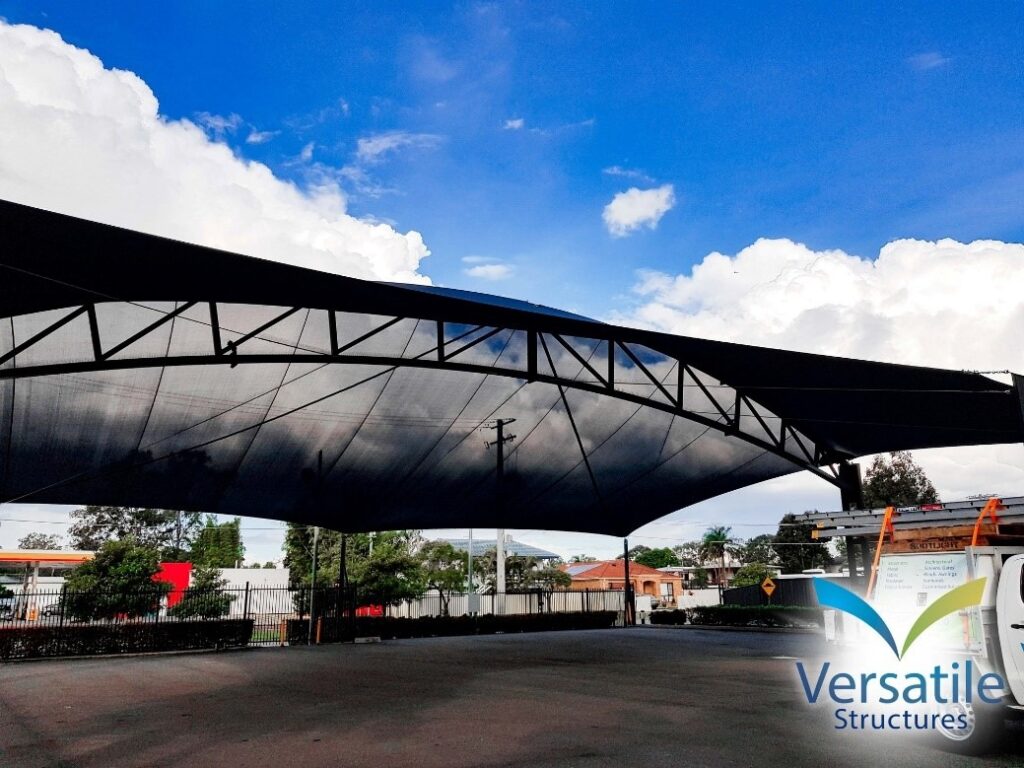YOU ARE HERE:

The Importance of Car Park Shade Structures
Jamie Howard In Car Park Shade Structure
As urban spaces continue to expand, the demand for efficient and comfortable parking facilities has become increasingly crucial. One innovative solution that addresses the challenges faced by parking lots is the installation of car park shade structures. In this article, we’ll explore the various aspects of these structures, answering key questions such as how parking lots are shaded, the concept of parking shade, the benefits of car parking shades, and the types of fabrics commonly used in their construction.
How Do You Shade a Parking Lot?
Shading a parking lot involves the strategic placement of structures designed to protect vehicles from the sun’s harsh rays. Car park shade structures come in various forms, including cantilevered shades, shade sails, and multi-panel structures. The installation process typically begins with a thorough analysis of the parking lot’s layout, taking into account factors such as the position of the sun, the size and shape of the parking spaces, and any architectural considerations.
Cantilevered shades are a popular choice for parking lots due to their versatile design. These structures feature a series of interconnected beams that extend outward from a support column, providing shade to a designated area. Shade sails, on the other hand, use tensioned fabric membranes to create a visually appealing and effective shading solution. Multi-panel structures incorporate multiple fabric panels supported by a network of columns, covering larger areas with ease.
The selection of the most suitable shade structure depends on the specific requirements of the parking lot, considering factors like the climate, local weather patterns, and the orientation of the parking spaces. Professional designers and engineers collaborate to create bespoke solutions that maximize shade coverage while maintaining the aesthetics and functionality of the parking facility.
What Is Parking Shade?
Parking shade refers to the practice of providing protection to vehicles in parking lots from the adverse effects of sunlight. This shade is typically achieved through the installation of purpose-built structures that act as barriers to the sun’s rays. The primary goal is to create a more comfortable environment for both vehicles and their occupants, addressing issues such as overheating, sun damage, and discomfort associated with prolonged sun exposure.
Parking shade is not merely a luxury; it is a practical and sustainable solution to enhance the usability and lifespan of parking facilities. By reducing the impact of direct sunlight on vehicles, these structures contribute to the overall well-being of both the drivers and the parked vehicles.
Benefits of Car Parking Shades
- Vehicle Protection: One of the most significant advantages of car parking shades is the protection they offer to vehicles. Prolonged exposure to sunlight can lead to interior fading, damage to the exterior paint, and increased temperatures inside the vehicle. Car park shade structures act as a barrier, minimizing these risks and preserving the aesthetic and functional aspects of the parked vehicles.
- Comfort for Users: Shaded parking lots create a more comfortable experience for drivers and passengers. The reduced exposure to direct sunlight means cooler vehicles and more pleasant interiors upon return. This added comfort enhances the overall satisfaction of users and contributes to a positive perception of the parking facility.
- Energy Efficiency: Car park shade structures play a role in energy conservation by reducing the need for air conditioning in parked vehicles. Cooler interiors mean less reliance on air conditioning systems, leading to lower fuel consumption and decreased greenhouse gas emissions. In addition, shaded parking lots contribute to a cooler overall environment, mitigating the urban heat island effect.
- Preservation of Infrastructure: The harsh effects of sunlight can take a toll on parking lot infrastructure. Car park shade structures protect surfaces such as asphalt and concrete from the damaging impact of prolonged exposure to UV rays. This preservation not only extends the lifespan of the parking facility but also reduces maintenance costs over time.
- Aesthetic Enhancement: Beyond their practical benefits, car park shade structures can be designed to enhance the visual appeal of parking facilities. Modern designs, vibrant colours, and creative configurations contribute to a more attractive and welcoming environment, improving the overall aesthetics of the urban landscape.
What Kind of Fabric Is Used for Parking Shades?
The choice of fabric for parking shades is a critical consideration in the design and construction process. Several factors influence the selection of fabric, including durability, UV resistance, and aesthetic appeal. Commonly used fabrics for car park shade structures include:
- High-Density Polyethylene (HDPE): HDPE is a popular choice for parking shade fabrics due to its excellent durability and UV resistance. It effectively blocks a significant portion of the sun’s rays while allowing air circulation, preventing the buildup of heat. HDPE fabrics are known for their longevity and resistance to weathering, making them suitable for various climates.
- Polyvinyl Chloride (PVC): PVC fabrics are another option for parking shade structures. They are known for their strength, versatility, and resistance to environmental factors. PVC fabrics can be coated to enhance their UV resistance, ensuring prolonged protection against sunlight. Additionally, PVC fabrics offer a wide range of colour options, allowing for creative and customized designs.
- Polytetrafluoroethylene (PTFE): PTFE-coated fabrics are valued for their exceptional durability and resistance to extreme weather conditions. These fabrics are highly effective in blocking UV rays and are known for their self-cleaning properties, reducing maintenance requirements. PTFE-coated fabrics are often used in architectural applications, providing a sleek and modern appearance.
- Acrylic: Acrylic fabrics are chosen for their vibrant colours and aesthetic appeal. While they may not have the same level of UV resistance as HDPE or PVC, acrylic fabrics are still effective in providing shade and can be treated to enhance their durability. Acrylic fabrics are often selected for their ability to create visually striking designs and patterns.
Conclusion
Car park shade structures represent a sustainable and practical solution to the challenges faced by parking facilities in urban environments. By strategically shading parking lots, these structures offer a range of benefits, including vehicle protection, enhanced user comfort, energy efficiency, infrastructure preservation, and aesthetic enhancement. The choice of fabric is a crucial element in the design process, with options like HDPE, PVC, PTFE, and acrylic offering different combinations of durability, UV resistance, and aesthetic possibilities.
As Brisbane continues to grow the importance of sustainability becomes more apparent, the integration of car park shade structures is likely to become a standard practice in urban planning. These structures not only contribute to the well-being of vehicle owners but also align with broader initiatives aimed at creating greener and more liveable urban spaces. Investing in car park shade structures is a forward-thinking approach that combines functionality, sustainability, and design to enhance the overall urban experience.
Share:
Jamie Howard - Director
Co-founder and Director Jamie has been hands-on in the shade and steel industry since leaving school. With over 15 years’ experience in shade, membrane and steel projects, Jamie is excited about the design opportunities shade structures offer in the commercial and industrial sectors. Jamie’s extensive design skills give him a competitive edge in situations with technical design complexity. He has won two personal industry awards for his designs, alongside many company-won awards.

